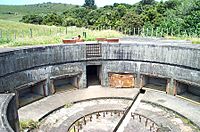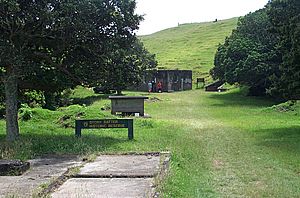Stony Batter facts for kids
Quick facts for kids Stony Batter |
|
|---|---|
| Waiheke Island, Auckland, New Zealand | |

One of the gun emplacements
|
|
| Type | Military defense |
| Site information | |
| Controlled by | New Zealand Department of Conservation |
| Open to the public |
Yes |
| Site history | |
| Built | 1943 |
Stony Batter is an old military base located at the top of Waiheke Island in New Zealand. It's inside a large park, also called Stony Batter, which is looked after by the New Zealand Department of Conservation (DOC). This park is special because it's both a historic site and a nature reserve. You can find cool rock formations, native bush, and three big concrete gun positions connected by a huge tunnel system. It's thought to be the biggest tunnel system in New Zealand!
Contents
Why Was Stony Batter Built?
Stony Batter was part of a bigger plan to protect Auckland from enemy ships. From the 1930s, New Zealand started building a network of gun batteries around the Hauraki Gulf. These batteries, like the ones at Whangaparaoa, Motutapu Island, and Stony Batter, were meant to stop enemy ships from getting close to the city.
The guns needed to shoot very far, over 30 kilometers! This was too far to see, so they had many observation posts. These posts, like the one on Rangitoto Island, helped them figure out where enemy ships were.
Building the Fort: A Secret Project
The idea for Stony Batter was approved in 1939. But building it was expensive, so it was put on hold. Then, during World War II, German ships were seen near New Zealand. Also, Japan joined the war in late 1941. Suddenly, building Stony Batter became very important!
In 1942, Waiheke Island was chosen for the site. The Public Works Department started building in 1943. It was a tough job because the location was far away and had no roads at first. The project was also kept a big secret. Workers had to live on site and make many of their own tools. The base was just called "A2" to hide its real location.
The tunnels and rooms underground were dug by hand. They used concrete to make the walls and ceilings strong. The rocks from the area were used to make the concrete, which is how Stony Batter got its name. The tunnels were finished in 1944. It cost a lot more than planned, but it was an amazing engineering achievement.
The Big Guns of Stony Batter
The guns at Stony Batter were huge! They were 9.2-inch guns, the largest ever used in New Zealand. They could shoot over 30 kilometers and fire one shot every minute. These guns could turn all the way around (360 degrees) and point up to 35 degrees.
Only two of these massive guns were ever installed. One arrived in 1944, and the second in 1948. The third gun was never sent. The guns were never fired in a real battle, only for testing and training. In 1961, they were taken apart and sold for scrap metal.
The gun pits had special rooms underneath them to store ammunition. Big electric lifts would bring the ammunition up to the guns.
Exploring the Tunnels
Stony Batter has about a kilometer of tunnels. Most of these tunnels can be explored on a guided tour. They connect the gun pits to each other and to the ammunition storage areas. There was also a plotting room where they calculated where to shoot, and an engine room that made electricity for the base. There were also storerooms and barracks (living quarters) above ground.
Stony Batter is now open to the public. A group called Fort Stony Batter Heritage Park Ltd. runs guided tours of the tunnels. They started tours in December 2020. The tunnels close for winter restoration work and usually reopen in December each year. You can find more details at www.stonybattertunnels.nz.
Images for kids






